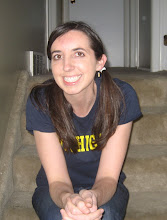Note to readers: I am in the process of creating a blog for parents of young children (and possibly older children as well), as a resource for supporting their children's mathematical literacy. Many parents I have talked to are eager to know what they can do to help their children, but don't always know where to start. I'd love to contribute what I can, and before I actually launch the blog, I am test running a couple of the posts I have already developed. I am interested in your feedback! What is helpful and what is not? Do you have any experiences as a parent that you would be willing to share? What kinds of things would you (or people you know) be interested in reading? I want to put something out into the world that is fun, interesting, and helpful, and I appreciate your help!
[I foresee five types of posts on the math blog: (1) games and activities to do with young children, (2) reviews of children's mathematics books with suggestions about how to engage children in the mathematics, (3) principles and guidelines for interacting with young children about mathematics, (4) descriptions of mathematical concepts that children are engaging in, and (5) accessible summaries of research about young children and mathematics. The following post is of the first type.]
[I foresee five types of posts on the math blog: (1) games and activities to do with young children, (2) reviews of children's mathematics books with suggestions about how to engage children in the mathematics, (3) principles and guidelines for interacting with young children about mathematics, (4) descriptions of mathematical concepts that children are engaging in, and (5) accessible summaries of research about young children and mathematics. The following post is of the first type.]
Four Super Simple Counting Games
- Why? Part of learning to count is recognizing that the number you say is how many there are, and that objects don’t have to be seen to have a count. Seeing whether your child can tell that the number of hidden objects is the same as the number they counted gives you insight into what they understand about counting.
- Variation: After your child has counted a set of objects, mix the objects up, push them closer together, or spread them farther apart, and ask how many there are. Early on, a child will recount the set. With counting experience, though, they will learn that moving objects around doesn’t change how many there are.
- Why? Build number sense! It’s horribly difficult to tell the difference between, say, 12 and 13 at a glance. But a collection of 7 things looks very different from a collection of 15 things. Guessing before counting can help children to get a sense of the relative size of different quantities.
- Variation: Give a child two options. For instance, if there are 6 swings at the park, ask, “Do you think there are 6 swings, or do you think there are 10 swings?”
- Why? This will help your child learn how to utilize the number sequence for simple addition and subtraction. Initially, children will need to re-count the set of objects, and that’s okay! Be sure to remind them how many there were before, and how many there are now. Eventually, your child may realize that all they have to do when you put one in is to say the next counting word, and all they have to do when you take one away is to say the previous counting word.
- Variation: If a child can play “Now How Many?” without recounting, begin removing or adding two objects at a time, or even three.
- Why? Being able to count backward is an important skill for early arithmetic. It also helps solidify a child’s familiarity with the number sequence.
- Variation: Count when you walk up or down stairs with your child. If you’re walking up or down an unfamiliar flight of stairs this could also be combined with “Guess the Number.” Guess how many stairs there are, and then count (up or down) to see if you’re right.









4 comments:
Sounds great!! I would love to do these activities with both of my girls...
This is so exciting! Good luck! When you're ready to go live, I'll spread the word around here.
Great, Amy. I want to do these with Jack, but also Gideon (just finished K) to make sure he really gets these concepts. I love the stairs one because it's such an everyday thing that could happen very naturally and be quite fun.
One thing I'd like to see is an explanation of how schools are now teaching math concepts. It is hard to help with homework when I do it "the old way". I would still check it my way, but I'd like to know where they're coming from so we can communicate better :)
These are great! I love that they are things you can just do during normal everyday activities. I'll try them out this week. :) Thanks!
Post a Comment